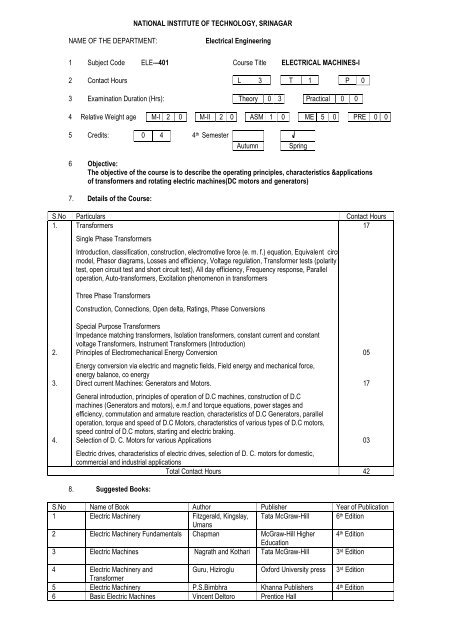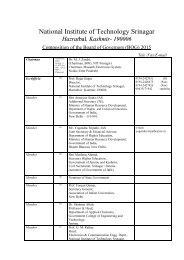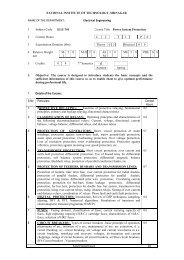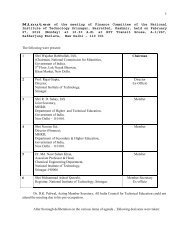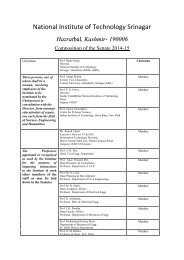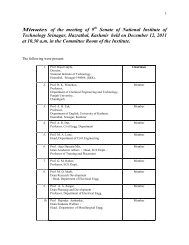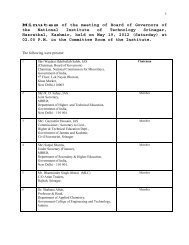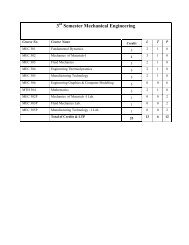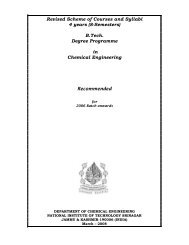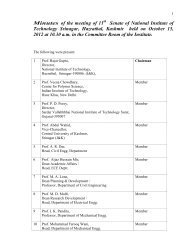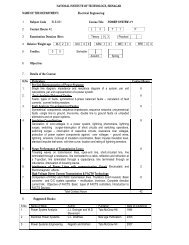Syllabus (4th Semester) - NIT Srinagar
Syllabus (4th Semester) - NIT Srinagar
Syllabus (4th Semester) - NIT Srinagar
Create successful ePaper yourself
Turn your PDF publications into a flip-book with our unique Google optimized e-Paper software.
NATIONAL INSTITUTE OF TECHNOLOGY, SRINAGARNAME OF THE DEPARTMENT:Electrical Engineering1 Subject Code ELE-–401 Course Title ELECTRICAL MACHINES-I2 Contact Hours L 3 T 1 P 03 Examination Duration (Hrs): Theory 0 3 Practical 0 04 Relative Weight age M-I 2 0 M-II 2 0 ASM 1 0 ME 5 0 PRE 0 05 Credits: 0 4 4 th <strong>Semester</strong>AutumnSpring6 Objective:The objective of the course is to describe the operating principles, characteristics &applicationsof transformers and rotating electric machines(DC motors and generators)7. Details of the Course:S.No Particulars Contact Hours1. Transformers17Single Phase TransformersIntroduction, classification, construction, electromotive force (e. m. f.) equation, Equivalent circuitmodel, Phasor diagrams, Losses and efficiency, Voltage regulation, Transformer tests (polaritytest, open circuit test and short circuit test), All day efficiency, Frequency response, Paralleloperation, Auto-transformers, Excitation phenomenon in transformersThree Phase TransformersConstruction, Connections, Open delta, Ratings, Phase ConversionsSpecial Purpose TransformersImpedance matching transformers, Isolation transformers, constant current and constantvoltage Transformers, Instrument Transformers (Introduction)2. Principles of Electromechanical Energy ConversionEnergy conversion via electric and magnetic fields, Field energy and mechanical force,energy balance, co energy3. Direct current Machines: Generators and Motors.General introduction, principles of operation of D.C machines, construction of D.Cmachines (Generators and motors), e.m.f and torque equations, power stages andefficiency, commutation and armature reaction, characteristics of D.C Generators, paralleloperation, torque and speed of D.C Motors, characteristics of various types of D.C motors,speed control of D.C motors, starting and electric braking.4. Selection of D. C. Motors for various ApplicationsElectric drives, characteristics of electric drives, selection of D. C. motors for domestic,commercial and industrial applicationsTotal Contact Hours 428. Suggested Books:S.No Name of Book Author Publisher Year of Publication1 Electric Machinery Fitzgerald, Kingslay, Tata McGraw-Hill 6 th EditionUmans2 Electric Machinery Fundamentals Chapman McGraw-Hill Higher 4 th EditionEducation3 Electric Machines Nagrath and Kothari Tata McGraw-Hill 3 rd Edition4 Electric Machinery andGuru, Hiziroglu Oxford University press 3 rd EditionTransformer5 Electric Machinery P.S.Bimbhra Khanna Publishers 4 th Edition6 Basic Electric Machines Vincent Deltoro Prentice Hall051703
NATIONAL INSTITUTE OF TECHNOLOGY, SRINAGARNAME OF THE DEPARTMENT:Electrical Engineering1 Subject Code ELE—401-P Course Title ELECTRICAL MACHINES-I Lab-I2 Contact Hours L 0 T 0 P 23 Examination Duration (Hrs): Theory 0 0 Practical 0 24 Relative Weight age MSLE 2 5 ESLE 2 55 Credits: 0 1 4 th <strong>Semester</strong>AutumnSpring6 Objective: The objective of the lab is to familiarize the students with different electric machines,their operation and working and to perform various tests on them.7. Lab. Experiments:S.No Experiments1 To perform open circuit and short circuit tests on a single-phase transformer2 To perform polarity test on a single phase transformer3 To determine the efficiency and voltage regulation of a single phase transformer4 To perform Sumpner’s test on two identical transformers5 To study three phase connections on a bank of three single phase transformers6 To study various parts of a dc machine and draw sketches of the same7 To plot the saturation curve of a dc machine8 To plot the external characteristics of a separately excited dc generator.9 To study the voltage build up of a dc shunt generator10 To plot the external characteristic of a dc shunt generator and compare the characteristics with thatof a separately excited generator11 To plot the external characteristics of a dc series generator.12 To plot the external characteristic of a dc compound generator and compare the characteristicswhen run as a shunt generator, an over compound generator, a flat compoundunder compound generator and differentially compounded generator.generator, an
NATIONAL INSTITUTE OF TECHNOLOGY, SRINAGARNAME OF THE DEPARTMENT:Electrical Engineering1 Subject Code ELE-–402 Course Title CONTROL SYSTEMS -I2 Contact Hours L 02 T 01 P 03 Examination Duration (Hrs): Theory 0 3 Practical 0 04 Relative Weight age M-I 2 0 M-II 2 0 ASM 1 0 ME 5 0 PRE 0 05 Credits: 0 3 4 th <strong>Semester</strong>AutumnSpring6 Objective: The objective of the course is to introduce the students to modeling, analysis anddesign of control systems which are an integral part of modern society and have widespreadapplication in science and industry.7. Details of the Course:S.No Particulars Contact Hours1. Introduction to continuous control systems:04Definition of a control system, open-loop, closed loop (automatic and manual)control.2. Mathematical modeling:Transfer functions, block diagrams, signal flow graphs 083. First and second order system:Example of first and second order systems, responses of these systems to step,ramp, parabolic and sinusoidal inputs, transient, steady state and error analysis4. Stability studies:Definition of stability, stability and pole locations, stability and Routh Table, stabilityand frequency response bode plot, polar plot, Nyquists criterion , root locus.5. Proportional, Integral, Derivative (P.I.D ) control. Compensator design Lead – lagcompensators . Modeling of dynamic systems in state space (Introduction).Total Contact Hours 421010108. Suggested Books:S.No Name of Book Author Publisher Year ofPublication1 Control Systems Engineering Norman S. Nise John wiley 20092 Control systems(Principles andDesign)M.GopalTata McGraw-HillPublishingSecondEdition3 Control systems A.Anand Kumar PHI Learning 2009Private limited4 Feedback control of dynamic systems Franklin and Powel. Prentice Hall 5 th Edition5. Design of feedback control systems Stefani Oxford universitypress
NATIONAL INSTITUTE OF TECHNOLOGY, SRINAGARNAME OF THE DEPARTMENT:Electrical Engineering1 Subject Code ELE--403 Course Title ELECTRICAL MEASUREMENTS ANDMEASURING INSTRUMENTS2 Contact Hours L 02 T 01 P 03 Examination Duration (Hrs): Theory 0 3 Practical 0 04 Relative Weight age M-I 2 0 M-II 2 0 ASM 1 0 ME 5 0 PRE 0 05 Credits: 0 4 4 th <strong>Semester</strong>AutumnSpring6 Objective: The objective of the course is to introduce the students to the basic concepts ofmeasurement, different measuring devices and various techniques used in the measurement ofelectrical quantities.7. Details of the Course:S.No Particulars Contact Hours1. Definition of basic terms used in measurements 022.14Electro-mechanical indicating instruments.Classification, efforts utilized in measuring instruments, various forces in an electromechanicalindicating instrument, errors and their types, various methods ofdamping, galvanometers (D’ Arsonal and Ballistic) Ammeters and Voltmeters(PMMC, Induction, Electrostatic and Dynamometer type), errors in voltmeters andammeters, extension of instrument range, ammeter shunts, voltmeter multipliers3. Measurement of Power, Energy and Power FactorPower measurement in three phase a.c. circuits using single phase and 3-phasewatt meter, measurement of reactive power (Single phase and 3 -phase), Energy07measurement using induction type meter, Energy meter testing, Power factormeter.4. Measurement of Resistance:Resistance classification, Measurement of Low resistance using potentiometermethod and Kelvin double bridge, Measurement of medium resistance usingammeter-voltmeter method, substitution method, Wheatstone bridge, Measurementof high resistance using loss of charge method, Meggar.5. Measurement of Inductance, Capacitance and Frequency using a.c bridges. 056. Potentiometers;04D.C potentiometers, Crompton potentiometer, application of D.C potentiometer, A.Cpotentiometers, Drysdale Tinsley and Cambell larsen Potentiometers, Applicationsof A.C Potentiometers7. Virtual Instrumentation:04Introduction to virtual Instrumentation. Measurement of Electrical and non-electricalquantities using virtual instruments.Total Contact Hours 428. Suggested Books:S.No Name of Book Author Publisher Year ofPublication1 Electrical Measurements and Golding, Widdis Pitman 5 th EditionMeasuring Instruments2 Electrical Electronic Measurements A.K.Sawhney. Dhanpat Rai 200606
NATIONAL INSTITUTE OF TECHNOLOGY, SRINAGARNAME OF THE DEPARTMENT:Electrical Engineering1 Subject Code ELE-403P Course Title ELECTRICAL MEASUREMENTSAND MEASURING INSTRUMENTSLABORATORY2 Contact Hours L 0 T 0 P 23 Examination Duration (Hrs): Theory 0 0 Practical 0 24 Relative Weight age MSLE 2 5 ESLE 2 55 Credits: 0 1 4 th <strong>Semester</strong>AutumnSpring6 Objective: The objective of the lab is to make students aware of various measuring techniquesand various measuring instruments used in the measurement of electric quantities.8. Lab. Experiments:S.No1ExperimentsMeasurement in single phase and three phase circuits using single phase and three phasewattmeters.2 Energy Measurement using watt-hour meter as well as using wattmeter and stop watch.3 To study the constructional details of an electromechanical indicating instrument with the help ofdemonstration type of instrument4 Measurement of Inductance and capacitance using Bridge techniques(Anderson’s Bridge, WheatStone’s Bridge.)5 Measurement of Resistance by different methods ( Loss of charge method, substitution Method,Kelvin’s Double Bridge)6 To Study RC and LC models of a transmission line and observe the variation of voltage magnitudeand phase along the line.7 Measurement of Electrical and Non Electrical quantities using virtual instrumentation. (Dasylab)
NATIONAL INSTITUTE OF TECHNOLOGY, SRINAGARNAME OF THE DEPARTMENT:Electrical Engineering1 Subject Code ELE-–404 Course Title NON-CONVENTIONALENERGY SOURCES2 Contact Hours L 03 T 0 P 03 Examination Duration (Hrs): Theory 0 3 Practical 0 04 Relative Weight age M-I 2 0 M-II 2 0 ASM 1 0 ME 5 0 PRE 0 05 Credits: 0 3 4 th <strong>Semester</strong>AutumnSpring6 Objective: The objective of this course is to introduce the students to the different Nonconventionaland renewable energy sources, their advantages and applications in day to day lifeand the methods of conversion of energy from these resources into usable form.7. Details of the Course:S.No Particulars Contact Hours1. Review of conventional & Non-conventional Energy resources, Energy problem, 08Energy & environment , Need for renewable.Relevant energy conversion systems & Technologies, Electricity generation, RuralEnergy.2. Wind & Solar Energy, Principles of power Gen. From wind, site selection, wind 11speed & power duration curves, wind power system components, Wind-DieselHybrid systems & recent developments. Solar radiation, solar collectors – flat plate& concentrating collectors, Solar water heaters & solar thermal power plants.Miscellaneous Applications3. Electric Power Generation from Tidal, OTEC & Geothermal energy. Simple power06plant based on Tidal / OTEC / Geothermal4. Direct Energy Conversion techniques, Why Direct Energy Conversion, Solar cell, 08principle and operation. Solar module & array, solar photovoltaic power system /solar wind Diesel system – operation & design. MHD & Thermo-Electric powergeneration.5. Energy conservation. Energy conservation in Transport sector, rural energy, urban 05energy, Industrial energy, power generation & distribution, Energy efficient buildings.Energy audit. Typical case studies.6. Future Energy Sources. Nuclear Fusion Energy – Tokamak reactor, Hydrogen 04Energy An introduction to power generation, advantages and limitations. Exploringnew energy sources. Economic evaluation of energy systems.Total Contact Hours 428. Suggested Books:S.No Name of Book Author Publisher Year ofPublication1 Non-Conventional Energy Resources R.K Singal Dhanpat Rai publication2 ,– Energy Technology S. Rao, B.B Parlekar Khanna Publications 3 rd edition3 Wind & Solar Power System M.Patel CRC Press4 Principle of Energy Conversion Culp-Mc Graw HillPublication
NATIONAL INSTITUTE OF TECHNOLOGY, SRINAGARNAME OF THE DEPARTMENT:Electrical Engineering1 Subject Code ECE –402 Course Title ELECTRONICS -II2 Contact Hours L 2 T 1 P 03 Examination Duration (Hrs): Theory 0 3 Practical4 Relative Weight age M-I 2 0 M-II 2 0 ASM 1 0 ME 5 0 PRE 0 05 Credits: 0 4 4 th <strong>Semester</strong>AutumnSpring6 Objective:The objective of the course is to introduce the students with basic electroniccircuits,their operations and applications7. Details of the Course:S.No Particulars Contact Hours1. Feedback Basics10Negative feedback, Effect of negative feedback on the performance of amplifierse.g. on bandwidth. Types of feedback amplifiers, current shunt, current series,voltage shunt, and voltage series feedback. Analysis of feedback amplifiers circuits2. Sinusoidal Oscillators:-05Basic operations, analysis of general oscillator circuit, Barkhausen’s criteria, varioustypes of oscillator circuits and their analysis, Design of practical oscillator circuits.3. Power Amplifiers and Power Supplies074.5.6.Classification of power amplifiers, Class A, Class B, Class AB and Class C poweramplifiers; analysis and design. Power supplies and IC regulatorsOperational Amplifiers:-Operational amplifiers stages, Differential amplifier, CMRR, Cascade amplifier, Idealand practical operational amplifier characteristics and properties OP ampapplications, inverting and non inverting amplifiers, difference amplifier, summer,differentiator and integrator, rectifiers etc. OP amp in analog computation.Frequency response, Gain Bandwidth product, Signal to noise ratio.Multivibrators and Wave Form GeneratorsBistable, Monostable and astable multivibrators circuits, and their analysis. Waveform generators, triangular and square wave generators.Logic families:Introduction to DTL, TTL, ECL, RTLCMOS Logic family; CMOS, Pseudo-nMos, Pass Transistor.CMOS invergter Static and dynamic operation, common CMOS Logic Gate circuits.Total Contact Hours 421005058. Suggested Books:S.No Name of Book Author Publisher Year ofPublication1 Integrated circuits Millman & Halkias Tata Mc-Graw Hill 20082 Microelectronic circuits Sedra and Smith Oxford university 5 th Edition3 Introduction to Electronic CircuitDesignSpencer and GhausiPress
NATIONAL INSTITUTE OF TECHNOLOGY, SRINAGARNAME OF THE DEPARTMENT:Electrical Engineering1 Subject Code ECE –402-P Course Title ELECTRONICS LAB - II2 Contact Hours L 0 T 0 P 23 Examination Duration (Hrs): Theory 0 0 Practical 0 24 Relative Weight age MSLE 2 5 ESLE 2 55 Credits: 0 1 4 th <strong>Semester</strong>AutumnSpring6 Objective:The objective of the lab is to make the students familirise with working of variouselectronic circuitry9. Lab. Experiments:S.No Experiments1 To assemble a differential amplifier and obtain its CMRR2 (i) To assemble current series feedback amplifier and study its performance.(ii) To assemble a voltage shunts feedback amplifier and study itsperformance.3 To assemble an RC phase shift oscillator.4 (a) Study performance of multivibrator circuits using 555 chip in followingModes:(i) Bistable(ii) Astable(iii) Monostable.(b) Use of 555 chip as a timer circuit.5 To assemble a schmitt trigger ckt. And to obtain its characteristics and to use it as Squaring circuit.6 To assemble a Class A power amplifier and to determine its power gain.7 To study different applications of OP-AMPS.(i)(ii)(iii)(iv)OP- AMP as an inverting amplifier.OP-AMP as a non-inverting amplifier.OP-AMP as an integrator.OP-AMP as a differentiator.8 To study the performance of a voltage regulator IC chip.9 To measure the following parameters of a typical OP-AMP.(i)(ii)(iii)(iv)10 MINI PROJECT:I/P Impedance(ii) O/P Impedance(iii) Slew rate (iv) CMRR(v) Freq. response.To design & fabricate a regulated power supply.
NATIONAL INSTITUTE OF TECHNOLOGY, SRINAGARNAME OF THE DEPARTMENT:Electrical Engineering1 Subject Code CIV-401 Course Title HYDAULICS AND HYDRAULICMACHINES2 Contact Hours L 02 T 01 P 03 Examination Duration (Hrs): Theory 0 3 Practical 0 04 Relative Weight age M-I 2 0 M-II 2 0 ASM 1 0 ME 5 0 PRE 0 05 Credits: 3 4 th <strong>Semester</strong>AutumnSpring6 Objective: To study water related phenomenon and their effect on the design and analysis ofwater retaining structures and water regulating structures7. Details of the Course:S.No Particulars Contact Hours1. INTRODUCTION:03PHYSICAL Properties of Fluids.2. Fluid Statics:Pressure Intensity, Pascal’s law, pressure density height relationships, manometers,pressure on plain and curved surfaces, centre of pressure.3. Kinematics of Fluid Flow:Types of flows, stream lines, streak lines and oath lines, continuity equation.4. Dynamics of fluid Flow:Euler’s equation of motion along a stream line and its integration to yield Bernouli’sequation flow measurement, pitot tube, prandtl tube, Venturimeter, orifice meter,orifices, Weirs and Matchces.5. Flow through Pipes:Hydraulic grade line, Darcey-weisbachh formulla, Design of pipes, Equivallentdiameter of pipes, Transmission of power through pipes.6. Flow in open Channels:Chezy’s formula, Mannings formula. Design of Cannels,Economic seciton.7. Hydraulic Machines:Types of turbines, description and principles of Impulse and reaction turbines, unitquantities and specific speed, run a ay speed, turbine characteristics, selection ofturbines, governing of turbines, centrifugal pumps, specific speed, Powerrequirement, Reciprocating pumps.8 Layout of power House:General layout and arrangement of Hydropower units.8. Suggested Books:Total Contact Hours 42S.No Name of Book Author Publisher Year ofPublication1 Fluid Mechanics & Fluid Power Dr D.S.KumarS.K.Kataria & 2008-09EngineeringSons2 Engineering Fluid Mechanics R.J.Garde & A.G.Miraj Scitech Publication3 A textbook of Fluid & HydraulicMachinesDr R.K Bansal Laxmi Publication 9 th Edition05040706050705
NATIONAL INSTITUTE OF TECHNOLOGY, SRINAGARNAME OF THE DEPARTMENT:Electrical Engineering1 Subject Code MTH –402 Course Title MATHEMATICS-IV2 Contact Hours L 02 T 01 P 03 Examination Duration (Hrs): Theory 0 3 Practical 0 04 Relative Weight age M-I 2 0 M-II 2 0 ASM 1 0 ME 5 0 PRE 0 05 Credits: 0 3 4 th <strong>Semester</strong>AutumnSpring6 Objective: The main objective of the couse is to make the students understand thefundamentals of complex varaiables and wavelet transforms. The application of complexvariables in determination of various electric quantities(for example electrostatic potential & flux)and the use of wavelet transforms in digital signal processing.7. Details of the Course:S.No Particulars Contact Hours1.Complex Variables:302.Review of Complex numbers, Applications of De-moivre’s theorem, complexfunctions, hyperbolic functions. Analytic functions, Cauchy Riemann equations,Complex integration, Cauchy’s fundamental theorem Cauchy’s integralformula,Cauchy’s inequality and Liouville’s theorem on integral function, Taylor’sand Laurent’s expansions, Zeros and poles of analytic functions, Residues andContour integration.Conformal Mappings, Bilinear Transformation.Wavelet Transform:12Continuous wavelet transform, Basic properties of wavelet transform, Discretewavelet transform, Orthonormal wavelets, Multi resolution analysis, Construction oforthonormal wavelets, Daubchies wavelets and algorithms. Band limited wavelets,Balian low theorem.Total Contact Hours 428. Suggested Books:S.No Name of Book Author Publisher Year ofPublication1 Complex Variables and Appications R.V.Churchill Mac- Graw 8 th edition2 Theory of functions Oxford university press3 Advanced Engineering Mathematics R.K.Jain and S.R.K.Iyenger,Narosa-2001.4 A first course on Wavelets Eugenio Hernandezand GuidoHillInternationalBookCompany.Weiss,C.R.C.Press,BocaRaton New York.Ten lectures on Wavelets I,Daubchies SIAM Publications
NATIONAL INSTITUTE OF TECHNOLOGY, SRINAGARNAME OF THE DEPARTMENT:Electrical Engineering1 Subject Code ELE –406 Course Title Electrical Machines (ECE)2 Contact Hours L 02 T 02 P 03 Examination Duration (Hrs): Theory 0 3 Practical 0 04 Relative Weight age M-I 2 0 M-II 2 0 ASM 1 0 ME 5 0 PRE 0 05 Credits: 0 4 4 th <strong>Semester</strong>AutumnSpring6 Objective: : The objective of the course is to describe the operating principles, characteristics&applications of transformers and rotating electric machines(DC motors and generatos)7. Details of the Course:S.No Particulars Contact Hours1. Transformers:10Operating principle, classification, construction, emf equation, phasor diagrams,equivalent circuit model, losses & efficiency, voltage regulation, frequencyresponse, polarity test, autotransformers, three-phase transformer connections,impedance matching, isolation & instrument transformers.2.10D.C. Machines:Operating principle, generator & motor action, construction, types of excitation, emf& torque equations, power stages & efficiency. Commutation & Armature Reaction,characteristics & application of d.c generators, starting & speed control of d.cmotors, characteristics & applications of d.c motors, electric braking.3. Induction Machines:10Three-phase induction motors. Principle of operation, construction, types. Rotatingmagnetic field, emf equation of an AC Machine, torque developed in an inductionmotor, equivalent circuit model, torque-speed characteristics, starting & speedcontrol.Single phase induction motors, starting, application4. Synchronous Machines:08Construction, types & operating principle of synchronous generator, A.C armaturewindings, equivalent circuit, phasor diagrams, voltage regulation, paralleloperation, synchronization, Power Angle characteristics, effect of fieldexcitation change.Synchronous Motor, principle, starting, hunting, damper windings.5. Special Purpose Motors:04Stepper Motor, Universal Motor, Shaded-pole Motor.Total Contact Hours 428. Suggested Books:S.No Name of Book Author Publisher Year ofPublication1 Electric Machinery Fitzgerald, Kingslay, Tata McGraw-Hill 6 th EditionUmans2 Electric Machinery Fundamentals Chapman McGraw-Hill 4 th EditionHigher Education3 Electric Machines Nagrath and Kothari Tata McGraw-Hill 3 rd Edition4 Electric Machinery andGuru, HizirogluOxford University 3 rd EditionTransformerpress5 Electric Machinery P.S.Bimbhra Khanna Publishers 4 th Edition6 Basic Electric Machines Vincent Deltoro Prentice Hall
NATIONAL INSTITUTE OF TECHNOLOGY, SRINAGARNAME OF THE DEPARTMENT:Electrical Engineering1 Subject Code ELE- ELE –406P Course Title Electrical Machines Laboratory2 Contact Hours L 0 T 0 P 13 Examination Duration (Hrs): Theory 0 0 Practical 0 24 Relative Weight age MSLE 2 5 ESLE 2 55 Credits: 0 1 4 th <strong>Semester</strong>AutumnSpring6 Objective: The objective of the lab is to familiarize the students with different electric machines,their operation and working and to perform various tests on them.10. Lab. Experiments:S.No Experiments1 To study various parts of a dc machine and draw sketches of the same.2 To plot the saturation curve of a dc machine.3 To plot the external characteristic of a dc shunt generator and compare the characteristics with thatof a separately excited generator.4 To plot the external characteristics of a dc series generator5 To perform open circuit and short circuit tests on a single-phase transformer6 To perform polarity test on a single phase transformer7 To determine the efficiency and voltage regulation of a single phase transformer8 Study of the construction of a synchronous machine,9 To obtain the OCC and SCC of a synchronous machine10 To synchronize an alternator with bus bars using bright / dark lamp method.11 To determine the equivalent–circuit parameters of a 3 - Induction motor by(i) No load test(ii) (ii) Blocked rotor test12 To determine the Torque / speed characteristics of a 3- Induction motor13 To study different methods of starting of single – phase induction motor.
NATIONAL INSTITUTE OF TECHNOLOGY, SRINAGARNAME OF THE DEPARTMENT:Electrical Engineering1 Subject Code ELE-–407 Course Title CONTROL SYSTEMS (ECE)2 Contact Hours L 02 T 01 P 03 Examination Duration (Hrs): Theory 0 3 Practical 0 04 Relative Weight age M-I 2 0 M-II 2 0 ASM 1 0 ME 5 0 PRE 0 05 Credits: 0 4 4 th <strong>Semester</strong>AutumnSpring6 Objective: : The objective of the course is to introduce the students to modeling, analysis anddesign of control systems which are an integral part of modern society and have widespreadapplication in science and industry.7. Details of the Course:S.No Particulars Contact Hours1. Introduction to continuous control systems:04Definition of a control system, open-loop, closed loop (automatic and manual)control.2. Mathematical modeling:08Transfer functions, block diagrams, signal flow graphs3. First and second order system:10Example of first and second order systems, responses of these systems to step,ramp, parabolic and sinusoidal inputs, transient, steady state and error analysis4. Stability studies:10Definition of stability, stability and pole locations, stability and Routh Table, stabilityand frequency response bode plot, polar plot, Nyquists criterion , root locus.5. Proportional, Integral, Derivative (P.I.D) control. Compensator design : Lead – lag10compensators . Modeling of dynamic systems in state space (Introduction), solutionof state – variable models using digital computers, an introduction to intelligentcontrol.Total Contact Hours 428. Suggested Books:S.No Name of Book Author Publisher Year ofPublication1 Control Systems Engineering Norman S. Nise John wiley 20092 Control systems(Principles andDesign)M.GopalTata McGraw-HillPublishingSecondEdition3 Control systems A.Anand Kumar PHI Learning 2009Private limited4 Feedback control of dynamic systems Franklin and Powel. Prentice Hall 5 th Edition5. Design of feedback control systems Stefani Oxford universitypress
NATIONAL INSTITUTE OF TECHNOLOGY, SRINAGARNAME OF THE DEPARTMENT:Electrical Engineering1 Subject Code ELE-407P Course Title CONTROL SYSTEMS Lab.(ECE)2 Contact Hours L 0 T 0 P 13 Examination Duration (Hrs): Theory 0 0 Practical 0 24 Relative Weight age MSLE 2 5 ESLE 2 55 Credits: 0 1 4 th <strong>Semester</strong>AutumnSpring6 Objective:The objective of the lab is make students understand the application of controlsystems in day to day life.11. Lab. Experiments:S.No Experiments1 To study the performance of Relay control Combination of P,I and D control schemes in a typicalthermal system.(oven)2 To study the torque-speed characteristics of an AC servomotor.3 To study the time response of a variety of simulated linear systems4 To study the role of feedback in a DC speed control system5 To study the role of feedback in a DC position control system.6 To study the role of a combination of P,I and D control actions in a variety of simulated linearsystems.7 To study the computer simulation of a number of systems.8 Use of MATLAB / SIMULINK /Control System tool boxes.
NATIONAL INSTITUTE OF TECHNOLOGY, SRINAGARNAME OF THE DEPARTMENT:Electrical Engineering1 Subject Code ELE-–405 Course Title NON-CONVENTIONAL ENERGYSOURCES (ECE)2 Contact Hours L 03 T 0 P 03 Examination Duration (Hrs): Theory 0 4 Practical 0 04 Relative Weight age M-I 2 0 M-II 2 0 ASM 1 0 ME 5 0 PRE 0 05 Credits: 0 3 4 th <strong>Semester</strong>AutumnSpring6 Objective: The objective of this course is to introduce the students to the different Nonconventionaland renewable energy sources, their advantages and applications in day to day lifeand the methods of conversion of energy from these resources into usable form.7. Details of the Course:S.No Particulars Contact Hours1. Review of conventional & Non-conventional Energy resources, Energy problem, 08Energy & environment , Need for renewables.Relevant energy conversion systems & Technologies, Electricity generation, RuralEnergy.2. Wind & Solar Energy, Principles of power Gen. From wind, site selection, wind 11speed & power duration curves, wind power system components, Wind-DieselHybrid systems & recent developments. Solar radiation, solar collectors – flat plate& concentrating collectors, Solar water heaters & solar thermal power plants.Miscellaneous Applications3. Electric Power Generation from Tidal, OTEC & Geothermal energy. Simple power06plant based on Tidal / OTEC / Geothermal4. Direct Energy Conversion techniques, Why Direct Energy Conversion, Solar cell, 08principle and operation. Solar module & array, solar photovoltaic power system /solar wind Diesel system – operation & design. MHD & Thermo-Electric powergeneration.5. Energy conservation. Energy conservation in Transport sector, rural energy, urban 05energy, Industrial energy, power generation & distribution, Energy efficient buildings.Energy audit. Typical case studies.6. Future Energy Sources. Nuclear Fusion Energy – Tokamak reactor, Hydrogen 04Energy An introduction to power generation, advantages and limitations. Exploringnew energy sources. Economic evaluation of energy systems.Total Contact Hours 428. Suggested Books:S.No Name of Book Author Publisher Year ofPublication1 Non-Conventional Energy Resources R.K Singal Dhanpat Raipublication2 ,– Energy Technology S. Rao, B.B Parlekar KhannaPublications3 Wind & Solar Power System M.Patel CRC Press4 Principle of Energy Conversion Culp-Mc Graw HillPublication3 rd edition
NATIONAL INSTITUTE OF TECHNOLOGY, SRINAGARNAME OF THE DEPARTMENT:Electrical Engineering1 Subject Code ELE-–407 Course Title CONTROL SYSTEMS(Information & Technology)2 Contact Hours L 02 T 01 P 03 Examination Duration (Hrs): Theory 0 3 Practical 0 04 Relative Weight age M-I 2 0 M-II 2 0 ASM 1 0 ME 5 0 PRE 0 05 Credits: 0 4 4 th <strong>Semester</strong>AutumnSpring6 Objective: : The objective of the course is to introduce the students to modeling, analysis anddesign of control systems which are an integral part of modern society and have widespreadapplication in science and industry.7. Details of the Course:S.No Particulars Contact Hours1. Introduction to continuous control systems:04Definition of a control system, open-loop, closed loop (automati c and manual)control.2. Mathematical modeling:Transfer functions, block diagrams, signal flow graphs3. First and second order system:Example of first and second order systems, responses of these systems to step,ramp, parabolic and sinusoidal inputs, transient, steady state and error analysis4. Stability studies:Definition of stability, stability and pole locations, stability and Routh Table, stabilityand frequency response bode plot, polar plot, Nyquists criterion , root locus.5. Proportional, Integral, Derivative (P.I.D) control. C ompensator design : Lead – lag 10compensators . Modeling of dynamic systems in state space (Introduction), solutionof state – variable models using digital computers, an introduction to intelligentcontrol.Total Contact Hours 428. Suggested Books:S.No Name of Book Author Publisher Year ofPublication1 Control Systems Engineering Norman S. Nise John wiley 20090810102 Control systems(Principles andDesign)M.GopalTata McGraw-HillPublishingSecondEdition3 Control systems A.Anand Kumar PHI Learning 2009Private limited4 Feedback control of dynamic systems Franklin and Powel. Prentice Hall 5 th Edition5. Design of feedback control systems Stefani Oxford universitypress
NATIONAL INSTITUTE OF TECHNOLOGY, SRINAGARNAME OF THE DEPARTMENT:Electrical Engineering1 Subject Code ELE-407P Course Title CONTROL SYSTEMSLABORATORY (IT)2 Contact Hours L 0 T 0 P 13 Examination Duration (Hrs): Theory 0 0 Practical 0 24 Relative Weight age MSLE 2 5 ESLE 2 55 Credits: 0 1 4 th <strong>Semester</strong>AutumnSpring6 Objective: The objective of the lab is make students understand the application of controlsystems in day to day life.12. Lab. Experiments:S.No Experiments1 To study the performance of Relay control Combination of P,I and D control schemes in a typicalthermal system.(oven)2 To study the torque-speed characteristics of an AC servomotor.3 To study the time response of a variety of simulated linear systems4 To study the role of feedback in a DC speed control system5 To study the role of feedback in a DC position control system.6 To study the role of a combination of P,I and D control actions in a variety of simulated linearsystems.7 To study the computer simulation of a number of systems.8 Use of MATLAB / SIMULINK /Control System tool boxes.
NATIONAL INSTITUTE OF TECHNOLOGY, SRINAGARNAME OF THE DEPARTMENT:Electrical Engineering1 Subject Code ELE-–405 Course Title NON-CONVENTIONAL ENERGY SOURCES(Information & Technology)2 Contact Hours L 03 T 0 P 03 Examination Duration (Hrs): Theory 0 4 Practical 0 04 Relative Weight age M-I 2 0 M-II 2 0 ASM 1 0 ME 5 0 PRE 0 05 Credits: 0 3 4 th <strong>Semester</strong>AutumnSpring6 Objective: The objective of this course is to introduce the students to the different Nonconventionaland renewable energy sources, their advantages and applications in day to day lifeand the methods of conversion of energy from these resources into usable form.7. Details of the Course:S.No Particulars Contact Hours1. Review of conventional & Non-conventional Energy resources, Energy problem, 08Energy & environment , Need for renewables.Relevant energy conversion systems & Technologies, Electricity generation, RuralEnergy.2. Wind & Solar Energy, Principles of power Gen. From wind, site selection, windspeed & power duration curves, wind power system components, Wind-DieselHybrid systems & recent developments. Solar radiation, solar collectors – flat plate& concentrating collectors, Solar water heaters & solar thermal power plants.Miscellaneous Applications3. Electric Power Generation from Tidal, OTEC & Geothermal energy. Simple powerplant based on Tidal / OTEC / Geothermal4. Direct Energy Conversion techniques, Why Direct Energy Conversion, Solar cell,principle and operation. Solar module & array, solar photovoltaic power system /solar wind Diesel system – operation & design. MHD & Thermo-Electric powergeneration.1106085. Energy conservation. Energy conservation in Transport sector, rural energy, urban 05energy, Industrial energy, power generation & distribution, Energy efficient buildings.Energy audit. Typical case studies.6. Future Energy Sources. Nuclear Fusion Energy – Tokamak reactor, Hydrogen 04Energy An introduction to power generation, advantages and limitations. Exploringnew energy sources. Economic evaluation of energy systems.Total Contact Hours 428. Suggested Books:S.No Name of Book Author Publisher Year ofPublication1 Non-Conventional Energy Resources R.K Singal Dhanpat Raipublication2 ,– Energy Technology S. Rao, B.B Parlekar KhannaPublications3 Wind & Solar Power System M.Patel CRC Press4 Principle of Energy Conversion Culp-Mc Graw HillPublication3 rd edition
NATIONAL INSTITUTE OF TECHNOLOGY, SRINAGARNAME OF THE DEPARTMENT:Electrical Engineering1 Subject Code ELE- ELE –406 Course Title ELECTRICAL ENGG. TECHNOLOGY(Mechanical Engineering)2 Contact Hours L 02 T 01 P 03 Examination Duration (Hrs): Theory 0 3 Practical 0 04 Relative Weight age M-I 2 0 M-II 2 0 ASM 1 0 ME 5 0 PRE 0 05 Credits: 0 4 4 th <strong>Semester</strong>AutumnSpring6 Objective: the objective of the course is to introduce the basic concepts of electrical engineeringto students, some basics of electric machines and some basic concepts of electricmeasurements techniques.7. Details of the Course:S.No Particulars Contact Hours1.Network Analysis and theorems: Basic Circuit theory (D.C and A.C.), Resistance’s,Inductance and capacitance, Ohm’s law, KCL, KVL, Power and energy relations,super-position theorem, Thevenin’s theorem, Norton’s theorem, Maximum powertransfertheorem.072.Sinusolidally –excited circuits: Basic definitions of a .c. circuits, phasor algebra andcomplex number representations, solutions of sinusolidally-excited R, L, C circuits.Introduction to 3-phase circuits.3.05Transformers: Construction, Principle of operation, Emf equation, Phasor diagrams,No Load and on load, Equivalent circuit model, Voltage-regulation and tests,Introduction to 3-phase transformers, Applications.4. D.C. Generators and motors: Basic construction, Principles of operation, Types of05d.c. generators and motors , Applications5.03Transducers: Definitions, Types of transducers and their applications formechanical measurements.6. Ammeters and voltmeters: Meter-range extension and their connections in the 04circuits.7 Bridge methods to measure: Resistance, inductance and Capacitance: Various 06types of bridges and their applications for measuring, R, L and C.8 Measurement of power and energy: Wattmeters, measurement of power using 06Wattmeters, Energy meters and measurement of electrical using energy meters.9 Digital Instruments: Introduction to digital meters for the measurement of various 02electrical quantitiesTotal Contact Hours 428. Suggested Books:S.No Name of Book Author Publisher Year ofPublication1 Principles of Electrical Engineering Vincent Del Toro. Prentice Hall042 Electric Machines Nagrath and Kothari. Tata McGraw-Hill 3 rd Edition3 Electric Machinery Fitzgerald, Kingsley , Tata McGraw-Hill 6 th EditionUmans4 Electrical Measurements and Golding, Widdis Pitman 5 th EditionMeasuring Instruments5 Electrical Electronic Measurements A.K.Sawhney. Dhanpat Rai 2006
NATIONAL INSTITUTE OF TECHNOLOGY, SRINAGARNAME OF THE DEPARTMENT:Electrical Engineering1 Subject Code ELE—406P Course Title ELECTRICAL ENGG. TECHNOLOGY LAB(Mechanical Engineering)2 Contact Hours L 0 T 0 P 13 Examination Duration (Hrs): Theory 0 0 Practical 0 24 Relative Weight age MSLE 2 5 ESLE 2 55 Credits: 0 1 4 th <strong>Semester</strong>AutumnSpring6 Objective:The objective of the lab is study the various basic electrical components andresponse in electric circuitry.their behaviour and13. Lab. Experiments:S.No Experiments1 To study the overall safety procedures to be employed while working with electric circuits.2 To study the series and parallel operation of resistors, inductors and capacitors.3 To verify(a) KVL and KCL in DC circuits.(b) Superposition theorem.(c) Thevenins Theorem4 To measure electric power in a single phase AC circuit with resistive load, R-L load and RLC load.5 To study the overall construction of electric machines6 Measurement of Electrical Energy by(i) KWH Meter(ii) Watt meter7 Measurement of power factor by(i)(ii)Power Factor meterVoltmeter, ammeter and watt meter method.
NATIONAL INSTITUTE OF TECHNOLOGY, SRINAGARNAME OF THE DEPARTMENT:Electrical Engineering1 Subject Code ELE-–407 Course Title CONTROL SYSTEMS (CSE)2 Contact Hours L 02 T 01 P 03 Examination Duration (Hrs): Theory 0 3 Practical 0 04 Relative Weight age M-I 2 0 M-II 2 0 ASM 1 0 ME 5 0 PRE 0 05 Credits: 0 4 4 th <strong>Semester</strong>AutumnSpring6 Objective:: The objective of the course is to introduce the students to modeling, analysis and design ofcontrol systems which are an integral part of modern society and have widespread application inscience and industry.7. Details of the Course:S.No Particulars Contact Hours1. Introduction to continuous control systems:04Definition of a control system, open-loop, closed loop (automatic and manual)control.2. Mathematical modeling:Transfer functions, block diagrams, signal flow graphs3. First and second order system:Example of first and second order systems, responses of these systems to step,ramp, parabolic and sinusoidal inputs, transient, steady state and error analysis4. Stability studies:Definition of stability, stability and pole locations, stability and Routh Table, stabilityand frequency response bode plot, polar plot, Nyquists criterion , root locus.5. Proportional, Integral, Derivative (P.I.D) control. Compensator design : Lead – lag10compensators . Modeling of dynamic systems in state space(Introduction), solution of state – variable models using digital computers, anintroduction to intelligent control.Total Contact Hours 420810108. Suggested Books:S.No Name of Book Author Publisher Year ofPublication1 Control Systems Engineering Norman S. Nise John wiley 20092 Control systems(Principles andDesign)M.GopalTata McGraw-HillPublishingSecondEdition3 Control systems A.Anand Kumar PHI Learning 2009Private limited4 Feedback control of dynamic systems Franklin and Powel. Prentice Hall 5 th Edition5. Design of feedback control systems Stefani Oxford universitypress
NATIONAL INSTITUTE OF TECHNOLOGY, SRINAGARNAME OF THE DEPARTMENT:Electrical Engineering1 Subject Code ELE-407P Course Title CONTROL SYSTEMS LAB.2 Contact Hours L 0 T 0 P 13 Examination Duration (Hrs): Theory 0 0 Practical 0 24 Relative Weight age MSLE 2 5 ESLE 2 55 Credits: 0 1 4 th <strong>Semester</strong>AutumnSpring6 Objective: The objective of the lab is make students understand the application of controlsystems in day to day life.14. Lab. Experiments:S.No Experiments1 To study the performance of Relay control Combination of P,I and D control schemes in a typicalthermal system.(oven)2 To study the torque-speed characteristics of an AC servomotor.3 To study the time response of a variety of simulated linear systems4 To study the role of feedback in a DC speed control system5 To study the role of feedback in a DC position control system.6 To study the role of a combination of P,I and D control actions in a variety of simulated linearsystems.7 To study the computer simulation of a number of systems.8 Use of MATLAB / SIMULINK /Control System tool boxes.
NATIONAL INSTITUTE OF TECHNOLOGY, SRINAGARNAME OF THE DEPARTMENT:Electrical Engineering1 Subject Code ELE-–405 Course Title NON-CONVENTIONAL ENERGY SOURCES(CSE)2 Contact Hours L 03 T 0 P 03 Examination Duration (Hrs): Theory 0 4 Practical 0 04 Relative Weight age M-I 2 0 M-II 2 0 ASM 1 0 ME 5 0 PRE 0 05 Credits: 0 3 4 th <strong>Semester</strong>AutumnSpring6 Objective: The objective of this course is to introduce the students to the different Nonconventionaland renewable energy sources, their advantages and applications in day to day lifeand the methods of conversion of energy from these resources into usable form.7. Details of the Course:S.No Particulars Contact Hours1. Review of conventional & Non-conventional Energy resources, Energy problem, 08Energy & environment , Need for renewables.Relevant energy conversion systems & Technologies, Electricity generation, RuralEnergy.2. Wind & Solar Energy, Principles of power Gen. From wind, site selection, wind 11speed & power duration curves, wind power system components, Wind-DieselHybrid systems & recent developments. Solar radiation, solar collectors – flat plate& concentrating collectors, Solar water heaters & solar thermal power plants.Miscellaneous Applications3. Electric Power Generation from Tidal, OTEC & Geothermal energy. Simple power06plant based on Tidal / OTEC / Geothermal4. Direct Energy Conversion techniques, Why Direct Energy Conversion, Solar cell, 08principle and operation. Solar module & array, solar photovoltaic power system /solar wind Diesel system – operation & design. MHD & Thermo-Electric powergeneration.5. Energy conservation. Energy conservation in Transport sector, rural energy, urban 05energy, Industrial energy, power generation & distribution, Energy efficient buildings.Energy audit. Typical case studies.6. Future Energy Sources. Nuclear Fusion Energy – Tokamak reactor, Hydrogen 04Energy An introduction to power generation, advantages and limitations. Exploringnew energy sources. Economic evaluation of energy systems.Total Contact Hours 428. Suggested Books:S.No Name of Book Author Publisher Year ofPublication1 Non-Conventional Energy Resources R.K Singal Dhanpat Raipublication2 ,– Energy Technology S. Rao, B.B Parlekar KhannaPublications3 Wind & Solar Power System M.Patel CRC Press4 Principle of Energy Conversion Culp-Mc Graw HillPublication3 rd edition


